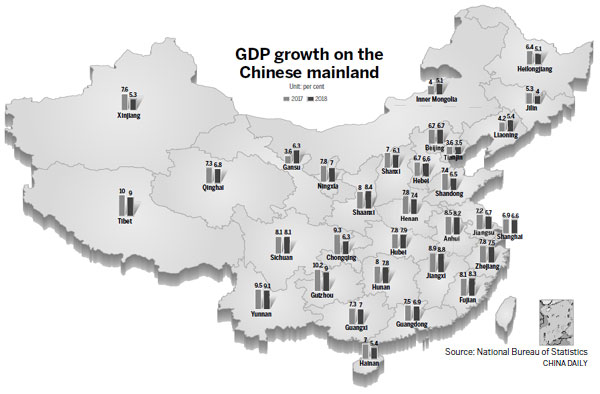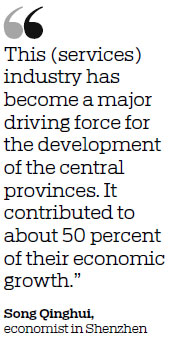
Expansion eases in provinces undergoing restructuring
A company in Guangdong province whose main business is selling electrical appliances made from a traditional type of porcelain has decided to increase its market presence through the use of new technology.
A new cooker produced by Guangdong Jians Yili Electrical Appliances that uses internally circulated steam and infrared technology is able to help reduce cholesterol in food, the company said.
It has an interior made of red porcelain, known as zisha in Chinese. The porcelain is rich in minerals that can break down fat in food as it cooks, helping to reduce cholesterol, officials said.
|
Left: Visitors are shown a digitalized city control center at the China International Big Data Industry Expo 2018 in Guiyang, Guizhou province. Right: Improving local infrastructure is one of the key ways of eradicating poverty in Tashikurgan, Xinjiang Uygur autonomous region. Photos by Tao Liang and Hu Huhu / Xinhua |

"Making an electrical appliance such as a cooker able to improve health through the introduction of innovative technology is of great importance in boosting our business," said Shi Zehua, chairman of Zhuhai HMH Industry Investment, an investor in the electrical appliance manufacturer.
Guangdong Jians Yili is one of many private enterprises driving the shift in the development focus of the province, a major southern economic hub.
Guangdong has the country's largest local economy. Its GDP exceeded 7 trillion yuan ($1.02 trillion) in the first three quarters of this year and could top 9 trillion yuan for the year - about the same as the GDP of Spain, which ranked 14th globally last year.
But Guangdong's growth rate has eased as it undergoes restructuring.
Other traditional Chinese economic powerhouses, mainly in eastern areas, have had a similar growth trajectory, as seen from third-quarter data released by provincial statistical bureaus, which provide a close look at the performances of different regions.
Western areas continued to lead in terms of economic expansion, with Yunnan province in Southwest China taking first place with year-on-year GDP growth of 9.1 percent, followed by Guizhou province and the Tibet autonomous region, both at 9 percent.
All 31 provinces, autonomous regions and municipalities have released their GDP figures.
Sixteen reported growth higher than the national rate, which was 6.7 percent in the first nine months; 13 registered growth lower than 6.7 percent; while the growth rate in Beijing and Jiangsu province was the same as the national figure.
Eastern restructuring
Eastern areas, which have traditionally led economic growth, have seen this ease in recent years as more emphasis has been placed on economic restructuring to strengthen their competitive edge and achieve more-sustainable development. This has seen the arrival of new growth drivers, such as the digital economy.
For example, in Zhejiang province, output in the digital economy rose by 14.8 percent in the first three quarters, much faster than the province's overall GDP growth.
In Beijing, new economy growth, such as that from information technology and the internet, reached 13.6 percent in the first three quarters, accounting for one-third of the municipality's GDP.
The capital's heavy investment in research and development is a major factor behind its prospering economy. Although it ranked 12th in terms of GDP scale among all the provinces, autonomous regions and municipalities, it was one of the top five in terms of investment in research and development.
Western growth
Three western regions, led by Yunnan and Guizhou, are in the top five of the country's fastest-growing.
They have registered high growth in recent years, taking advantage of technological advancement to speed their economic expansion.
Given their lower level of economic development, their production-related costs, such as labor and land prices, have been at relatively low levels, making them ideal destinations for industrial transfers from the more developed eastern regions, analysts said.
Moreover, some of them, such as Guizhou, have taken advantage of the fast growth in emerging industries, such as IT and the internet, to propel their economic growth, said Song Qinghui, an independent economist in Shenzhen, Guangdong.
Guizhou, for instance, decided to focus on the development of big data in 2014, hoping to make it a major pillar of its economy.
Home to more than 4,000 big data enterprises, the province has become a major national big data center, with a number of multinationals, such as Microsoft, Apple, Alibaba and Huawei Technologies, establishing branches there. The big data industry contributed about 20 percent of Guizhou's economic growth from 2014 to last year.
"The fast rise of emerging industries has constituted a strong driving force for the continual growth of western economies," Song said.
Although their growth has led the nation's, western areas have seen their economic expansion slow due to the overall weakening of the national economy.
Guizhou's GDP growth in the first three quarters was 1 percentage point lower than in the first half of this year, while that in Yunnan slowed to 9.1 percent, down from 9.5 percent last year.
Central provinces

Investment has contributed significantly to growth in central provinces. In Anhui, fixed asset investment increased by 11.9 percent, up by 1.9 percentage points year-on-year and 6.5 percentage points higher than the national level. Thanks to the support of rapid fixed asset investment growth, Anhui has been relatively resilient against the backdrop of a slowing national economy, analysts said.
The services industry has also made a major contribution to the high economic growth of those provinces.
"This industry has become a major driving force for the development of the central provinces. It contributed to about 50 percent of their economic growth," Song said. "The ratio is still on the rise."
Causes of weakening
Compared with last year, GDP growth of many local economies has weakened. For instance, growth in Yunnan, which was 9.1 percent in the first three quarters, the fastest in the country, was significantly lower than that of Guizhou, which registered the fastest growth nationally of 10.2 percent last year.
Local economies weakened as national economic growth fell to 6.5 percent in the third quarter from 6.8 percent in the first. This was due to falling infrastructure investment and consumption, tightened financial regulations and environmental protection measures that have affected liquidity and production in some areas, weak external demand, and uncertainties caused by the recent China-US trade disputes.
Faced with slowing growth, the central authorities adjusted their regulatory stance by adopting targeted measures in some sectors to channel funds into the real economy and infrastructure construction, steps that have benefited local growth.
The Sino-US trade disputes have affected some local economies, mainly the exporting eastern provinces.
Some areas, such as Zhejiang, Jiangsu and Shanghai, may be affected the most by the trade disputes between the two countries, Song said.
"We expect to see disruption in a number of provinces that rely heavily on trade for economic growth, including Guangdong, Jiangsu, Zhejiang, along with Shanghai. These areas are China's traditional exporting powerhouses, accounting for more than half of the country's total export flows in 2017," the Economist Intelligence Unit said in a report in September.
Last year, exports as a percentage of regional GDP stood at 50 percent in Guangdong, almost 40 percent in Zhejiang and Shanghai and at about 30 percent in Jiangsu, according to the report.
These areas will have to face changes and work out solutions. "They need to adapt to the new situation through product innovation, industrial upgrading and tapping new markets in other countries, such as those involved in the Belt and Road Initiative," Song said.
Strengthened environmental protection measures have also affected local growth, according to a research note by Everbright Securities.
"These measures have had some impact on local growth, but the effect is waning ... after the authorities banned some local practices, such as willfully stopping production in factories, which violated regulations," the note said.
Statistical reform
Strict implementation of the statistics law also has had an effect on the results of local economies as the central authorities have tightened monitoring of statistical bureaus, the securities firm said.
Since 2016, the authorities have released a series of documents urging that the quality of statistics be improved and that those involved in falsifying data be severely punished.
The total for the GDP figures reported by all provinces, regions and municipalities is often higher than the final one calculated by the National Bureau of Statistics. This is either for technical reasons, such as duplicated calculation by local bureaus, or falsifying of figures by local officials.
Last year, the total for all local GDP figures was 2.4 percent higher than the figure calculated by the NBS, but the gap was significantly narrower than in previous years, showing that tightened top-level statistical monitoring has played a role in improving the accuracy of GDP calculation, Everbright Securities said.
From next year, the NBS will reform the system used to collect and calculate data. At present, city and provincial statistics bureaus collect information, such as output data, for their jurisdictions and calculate GDP scale, but after the reforms are introduced, this power will be transferred to higher authorities.
As a result, central statistical authorities will be in charge of calculating provincial-level GDP, and provincial bureaus will handle GDP calculation for cities.
Such reforms aim to avoid falsification of GDP figures and make statistics more accurate, analysts said.
"The move will help unify national data and local statistics," said Cai Zhizhou, a statistics professor at Peking University.
(China Daily 12/04/2018 page1)